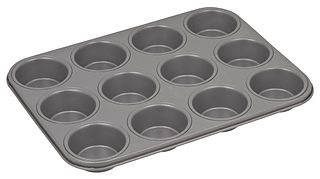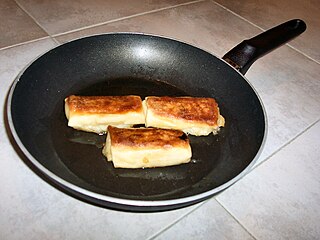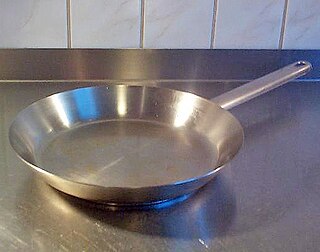
Polytetrafluoroethylene (PTFE) is a synthetic fluoropolymer of tetrafluoroethylene that has numerous applications. The best known brand name of PTFE-based formulas is Teflon by Chemours. Chemours is a spin-off of DuPont, which originally discovered the compound in 1938. Another popular brand name of PTFE is Syncolon® by Synco Chemical Corporation.

Cookware and bakeware are types of food preparation containers, commonly found in a kitchen. Cookware comprises cooking vessels, such as saucepans and frying pans, intended for use on a stove or range cooktop. Bakeware comprises cooking vessels intended for use inside an oven. Some utensils are considered both cookware and bakeware.

A bread pan, also called a loaf pan, is a kitchen utensil in the form of a container in which bread is baked. Its function is to shape bread while it is rising during baking. The most common shape of the bread pan is the loaf, or narrow rectangle, a convenient form which enables uniform slicing. The bread pan is made from a conductive material such as metal which might be treated with a non-stick coating. It can also be made of heat resistant glass, ceramic, or a special type of paper that sticks to the dough but is easily removed, once cooked. Bread pans are found in a variety of designs and sizes providing the baker with different possibilities not only for baking bread, but also cakes and puddings.

All-Clad Metalcrafters, LLC is a U.S. manufacturer of cookware with headquarters in Canonsburg, Pennsylvania. The company markets its cookware to department stores and specialty stores in the United States, Australia, Canada, Germany, and the UK, along with All-Clad bonded ovenware, kitchen tools, and kitchen accessories.
Cooking spray is a spray form of an oil as a lubricant, lecithin as an emulsifier, and a propellant such as food-grade alcohol, nitrous oxide, carbon dioxide or propane. Cooking spray is applied to frying pans and other cookware to prevent food from sticking. Traditionally, cooks used butter, shortening, or oils poured or rubbed on cookware. Most cooking sprays have less food energy per serving than an application of vegetable oil, because they are applied in a much thinner layer: US regulations allow many to be labelled "zero-calorie"; in the UK sprays claim to supply "less than 1 calorie per serving". Popular US brands include Pam, Crisco, and Baker's Joy. Sprays are available with plain vegetable oil, butter and olive oil flavor.

Cast-iron cookware is valued for its heat retention properties and can be produced and formed with a relatively low level of technology. Seasoning is used to protect bare cast iron from rust and to create a non-stick surface. Types of bare cast-iron cookware include panini presses, waffle irons, crepe makers, dutch ovens, frying pans, deep fryers, tetsubin, woks, potjies, karahi, flattop grills and griddles.

A muffin tray is a mold in which muffins or cupcakes are baked. A single cup within a regular muffin tin is 3 1⁄2 ounces and most often has room for 12 muffins, although tins holding 6, 8, 11, 24, and 35 muffins do exist. A single cup within a mini muffin tin is 2 1⁄8 ounces, and because these are less common, there are several standard numbers of cups per tin, including 6, 12, and 24 cups per tin. A single cup within a jumbo muffin tin is 8 3⁄16 ounces, and again because these are uncommon, there are several standard numbers of cups per tin, including 4, 6, and 12 cups per tin.

A non-stick surface is a surface engineered to reduce the ability of other materials to stick to it. Non-stick cookware is a common application, where the non-stick coating allows food to brown without sticking to the pan. Non-stick is often used to refer to surfaces coated with polytetrafluoroethylene (PTFE), a well-known brand of which is "Teflon." In the twenty-first century other coatings have been marketed as non-stick, such as anodized aluminium, ceramics, silicone, enameled cast iron, and seasoned cookware. Superhydrophobic coating is the newest non-stick coating for sale.
Polyhalogenated compounds (PHCs) are any compounds with multiple substitutions of halogens. They are of particular interest and importance because they bioaccumulate in humans, and comprise a superset of which has many toxic and carcinogenic industrial chemicals as members. PBDEs, PCBs, dioxins (PCDDs) and PFCs are all polyhalogenated compounds. They are generally non-miscible in organic solvents or water, but miscible in some hydrocarbons from which they often derive.

Parchment paper, baking paper, or bakery release paper are cellulose-based papers that have been treated or coated to make them non-stick. They are used in baking as a disposable non-stick surface. They should not be confused with wax paper or waxed paper, which is paper that has been impregnated with wax.

Seasoning is the process of treating the surface of a cooking vessel with a stick-resistant coating formed from polymerized fat and oil on the surface.
Xylan is a fluoropolymer-based industrial coating. Generally, it is applied in a thin film to the target material.

A roasting pan is a piece of cookware used for roasting meat in an oven, either with or without vegetables or other ingredients. A roasting pan may be used with a rack that sits inside the pan and lets the meat sit above the fat and juice drippings.
In cooking several factors, including materials, techniques, and temperature, can influence the surface chemistry of the chemical reactions and interactions that create food. All of these factors depend on the chemical properties of the surfaces of the materials used. The material properties of cookware, such as hydrophobicity, surface roughness, and conductivity can impact the taste of a dish dramatically. The technique of food preparation alters food in fundamentally different ways, which produce unique textures and flavors. The temperature of food preparation must be considered when choosing the correct ingredients.
Ecolon may refer either to recycled mineral-glass reinforced Nylon 6 (Perlon) engineering resins, or to a ceramic filled fused silica coating commonly used in cookware (Ecolon).
Vinod Intelligent Cookware, is an Indian manufacturer of cookware. Over the years,Vinod cookware has built its image and a strong connection with home makers. After a decade experience and repertoire of over 400 products spread across seven categories, Vinod Cookware’s Pressure Cooker is the firms biggest success story as it has manifested the launch of ‘Sandwich bottom’ in the history of Indian kitchens. Vinod Intelligent cookware launched Aluminium Sandwich Bottom Cookware and was widely accepted as a more reasonable alternative to copper.
Visions is a brand of transparent stove top cookware created by Corning France and introduced to Europe during the late 1970s. In 1983, it was introduced in the United States and became the number one selling cookware set for a number of years. Visions is made of Calexium, a transparent material belonging to the Pyroceram family of glass-ceramics. It is one of the few cookware lines than can be used on the range, in the oven, and under a broiler. It will withstand heat up to 850 °C (1,560 °F) with thermal traits similar to Corning Ware plus improved resistance to staining and the detrimental effects of acids and detergents. Visions is sold worldwide by Corelle Brands, LLC.
Marc Grégoire (Tefal) was the inventor of nonstick pans. When his wife learned of an ONERA engineer using Teflon to assist in the removal of glass fibre moulds, she challenged him to create some non-stick cookware. He attached Teflon to the base of an aluminum frying pan. It was Grégoire who found a way to bond PTFE to aluminum creating the first ever nonstick cookware which later became the world leader in nonstick pans. In 1956 Grégoire and his wife launched the Tefal Corporation developing the slogan: La Poêle Tefal, la poêle qui n’attache vraimant pas In 2018 it is still regarded as one of the best non-stick pans.










